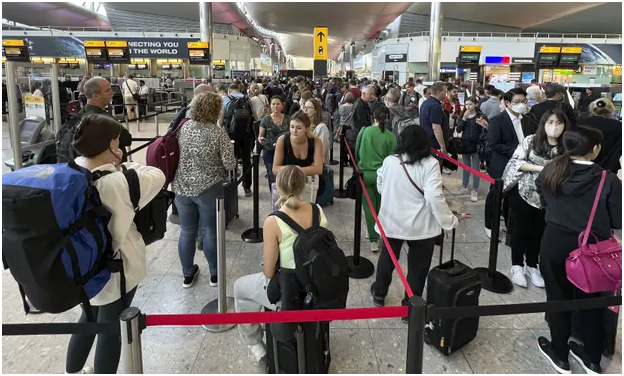What has gone wrong at Heathrow? The airport that confidently laid out expansion plans and charged its customers a hefty premium has been repeatedly suffering the kind of chaos people pay money to avoid: flight cancellations, long queues, lost baggage mountains and strike threats. Now, at the start of the full summer peak, it has told airlines to turn passengers away.
In a week when baking temperatures swept across Britain, few places were feeling the heat more. Heathrow’s own posters highlighting the “elephant in the room” – aviation’s contribution to climate change – have never looked more apposite as the mercury hit a record 40.2C at the airport, the grass between its runways parched a desert brown.

Last week, Heathrow announced a 100,000 daily cap on passengers until 11 September, infuriating airlines and putting thousands of customers’ plans in jeopardy. The airport insisted it was “protecting holidays”, but the response was fierce. Emirates initially refused point blank to comply or cancel flights. In some of the milder invective, Willie Walsh, the director general of Iata – and an old frenemy from running British Airways and its parent group, IAG – has described Heathrow as “a bunch of idiots when it comes to running airports”.
Anxious storm clouds of passengers
Inside the airport terminals this week, the line between exceedingly busy and frantic was thin. At least, though, the air conditioning was working. In a late morning lull in Terminal 5, it did not look like chaos. “Give it a couple of hours,” a BA staffer at the queueing ropes said, grinning, a mild sweat on. “It just comes and goes … Just random.”
The airline sector’s turmoil is self-perpetuating: huge queues grow with anxious passengers turning up ever earlier for flights. Wider travel disruption does not help: installed with laptop and luggage in Pret, one seasoned traveller said he had arrived nine hours before his flight to Australia, after warnings that the heat could halt the trains he needed for the airport.
The adjacent Terminal 2 is Heathrow’s most modern addition – opened in 2014 with the optimistic objective of passengers traversing to and from the plane in minutes, without traditional check-in lanes. Now though, a man in a suit was explaining patiently over and again to customers that despite checking in online, they must still enter the daunting United Airlines queue to comply with US security procedures.
All around, various staff – in airline livery, hi-vis vests or the pink polo shirts of “Heathrow helpers” – are marshalling incoming groups that appear and disperse like rumbling storm clouds.
Post-Covid restrictions, with corporate travel down, ever fewer passengers are likely to be mobile, unencumbered, tech-savvy frequent flyers. many here are non-English speaking, with large amounts of luggage; old, young, infirm, faced by bewildering layouts, prompts for QR codes and additional Covid documentation, and needing assistance of all kinds.
And if terminals can appear chaotic, the worst problems have been airside. Delays today are relatively minor but the arrivals board now has an additional feature alongside a flight’s landing time: whether its bags have been delivered or are arriving. While BA’s flight from Kuwait landed more than 90 minutes ago, the bags have yet to make it to the carousels.
So cutting passenger numbers by just a few thousand can make a huge difference to those who do travel, according to Heathrow’s chief executive, John Holland-Kaye, defiant in Terminal 5 on Tuesday, after mounting speculation over his future. “We’re taking action with the cap to protect people’s holidays. We’ve got 100,000 passengers travelling through today, it’s the hottest day we’ve ever had, and the airport is working smoothly. That shows that the action we’re taking, in difficult circumstances, is working.”
Pointing the finger
Holland-Kaye said no one wanted a “blame game”, but said the overriding factor was a lack of airline ground handling staff, either contracted out – to companies such as Menzies, Swissport or Cobalt – or directly employed. The main effect of the cap will be limiting further ticket sales, but about 1,500 passengers on the busiest summer days will be forced to change their plans, on top of the hundreds of thousands already bumped by mass BA cancellations ordered earlier this summer.
“The reality is that if the airport, airlines, or ground handlers don’t have enough capacity, people are not going to get away on their flights in a much worse way: their flights cancelled after they’ve checked in, maybe even on the plane,” Holland-Kaye said. “That’s the worst of all worlds.”
Labour shortages have been worsened by lengthy background checks for new recruits and competition from other sectors.
Surprisingly few things actually come under the airport’s direct remit, bar the security officers and provision of the infrastructure. Airlines run check-in. The immigration hall, scene of previous years’ headline-hitting queues, is the responsibility of the Home Office and its Border Force employees. While the automated baggage systems are (usually) kept functioning by Heathrow, the handlers who put the bags in or take them off are employed, or contracted, by airlines.
Even the people on the tarmac, driving trucks to bring luggage, attaching air bridges or pushing back aircraft from the stand, are the airlines’ direct or outsourced staff.
‘Excessive’ shareholder returns
Airlines, however, point to multiple Heathrow failures: the understaffed security that saw long queues at Easter; the unreliable baggage system; and a failure to plan before the cap, brought in at the 11th hour. As Holland-Kaye himself put it, there are 400 separate companies working at the airport, and his role is to “keep all of them working in tandem”.
While airlines such as BA have concurred and cut ever more flights from their schedule to keep the plates spinning, the latest standoff has played out to a backdrop of a bitter row over landing charges. Heathrow had proposed to double the price, set by the UK regulator, that it can make airlines pay per passenger.
That prompted a furious backlash from carriers who have sustained huge losses and query whether Heathrow’s shareholders – largely Qatar and other sovereign wealth funds – should be digging deeper, after taking £4bn in dividends in the last decade.
Heathrow’s ever-increasing debt, up to £15.4bn at last count, has financed investment that directly raises returns the more it builds, under the regulatory system. Airlines see it as enjoying an enviably stable position – or as the chief executive of Virgin Atlantic, Shai Weiss, put it: “Abusing its monopoly position to fleece passengers and deliver excessive returns to shareholders.”
At the Farnborough airshow this week, Walsh said Heathrow was unprepared for the strength of recovery because of its own pessimistic forecasting, which he claimed was to “game” the regulator to allow it to hike landing charges. While airlines had spotted pent-up demand recovery, Heathrow played it down. Holland-Kaye rejects the accusation, saying airlines should have hired more handlers earlier if they expected the bounce back.
The blame game appears to have some way to run – as do the problems. Holland-Kaye says it will take 12-18 months for the staffing issues to resolve. The cap may not lift for half-term or Christmas, he hinted: “They have about 70% of the staff trying to serve about 80-85% of the passengers and that doesn’t work.”







